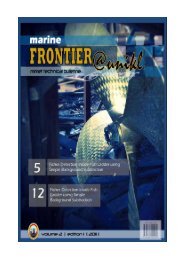click here to download - UniKL MIMET Official Website
click here to download - UniKL MIMET Official Website
click here to download - UniKL MIMET Official Website
You also want an ePaper? Increase the reach of your titles
YUMPU automatically turns print PDFs into web optimized ePapers that Google loves.
Fuel system<br />
In maintaining such a speed for a long time<br />
about 3,000 <strong>to</strong>nnes diesel are required on‐<br />
board. That is about the same weight as the<br />
cargo. Methanol and ethanol are also <strong>to</strong>o<br />
heavy. T<strong>here</strong>fore hydrogen is used in the fuel<br />
system. It releases a lot more energy per kilo‐<br />
gram than conventional fuels, and the fuel de‐<br />
livery system devised can use both liquid and<br />
gaseous hydrogen, so no fuel is wasted.<br />
0.86kg of liquid hydrogen per second is<br />
required in order <strong>to</strong> operate the turbines at<br />
speed of 64 knots. This means 176 m³ of hydro‐<br />
gen burned every hour. For a ship <strong>to</strong> travel the<br />
distances required, it would t<strong>here</strong>fore require a<br />
fuel s<strong>to</strong>rage capability of 14,500 m³. The design<br />
of the Oceanjet allows for ten separate but in‐<br />
terconnected fuel tanks, with a <strong>to</strong>tal s<strong>to</strong>rage<br />
capacity of 1,001 <strong>to</strong>nnes of liquid hydrogen.<br />
Safety first<br />
Fig. 3: Hydrogen Oceanjet 600<br />
Naturally, the use of liquid hydrogen raises<br />
a number of key safety questions, not least how<br />
volatile a liquid fuel can be inside a ship travel‐<br />
ling in excess of 60 knots. Because of hydrogen<br />
behaves differently compared <strong>to</strong> other conven‐<br />
tional fuels, it requires a different approach al‐<br />
<strong>to</strong>gether. Current shipbuilding regulations do<br />
not allow for the use of liquid hydrogen as a<br />
fuel source.<br />
The liquefied hydrogen is kept at ‐253°C<br />
for safety reason. A safety system can vent the<br />
<strong>MIMET</strong> Technical Bulletin Volume 1 (2) 2010<br />
hydrogen quickly in the event of an accident.<br />
Liquid hydrogen turns <strong>to</strong> gas instantaneously<br />
when in contact with the air and does not linger<br />
and burn longer like other fuels such as kero‐<br />
sene.<br />
SMART H‐2 Project<br />
The progress within the SMART‐H2 has<br />
been excellent. Already launched is an auxiliary<br />
engine on board a whale watching ship<br />
“Elding”. The opening ceremony was held at the<br />
harbour of Reykjavik, Iceland on April 24th 2008<br />
when media and guests were invited on the first<br />
trial run of using hydrogen on board a commer‐<br />
cial vessel.<br />
Fig. 4 “Elding”<br />
| MARINE FRONTIER @ <strong>UniKL</strong><br />
20



